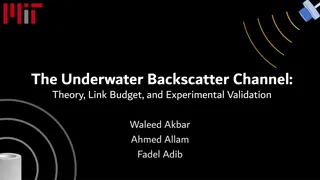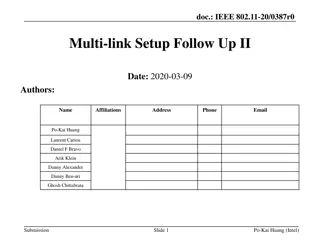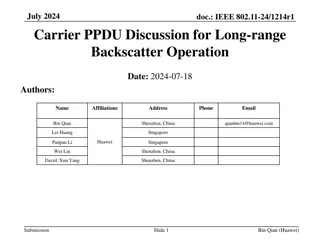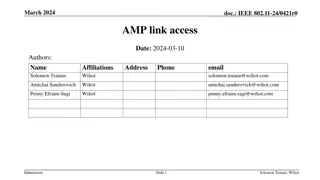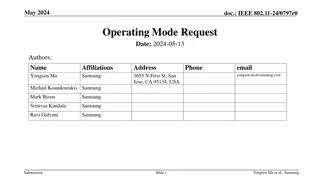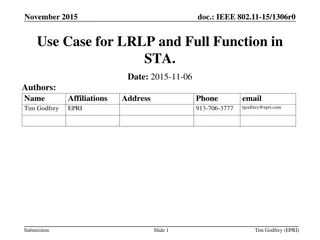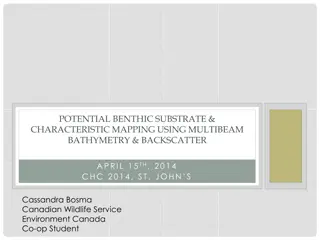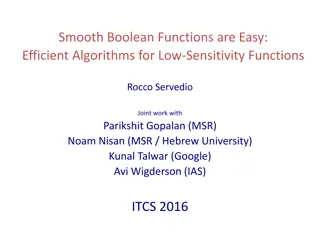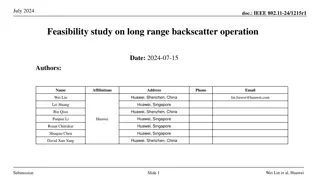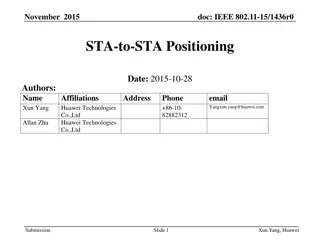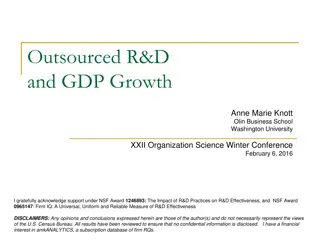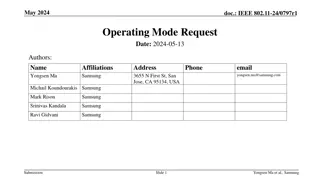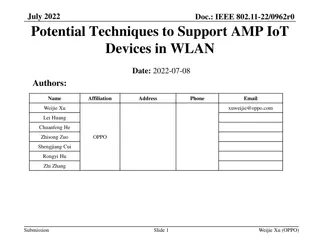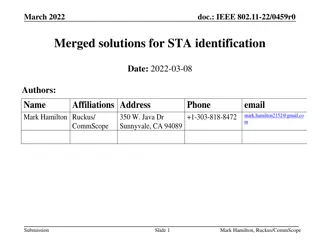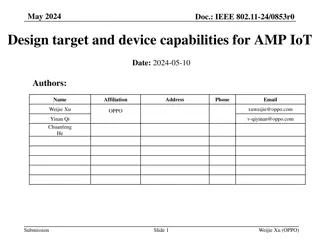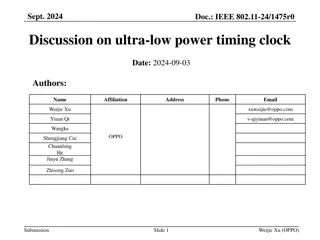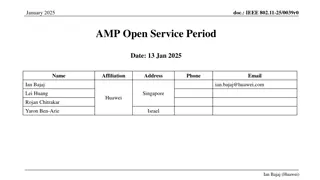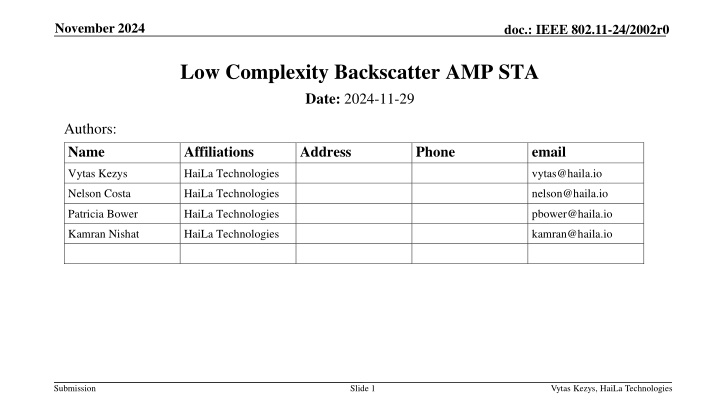
Reducing Complexity in IEEE 802.11-24/2002r0 Backscatter AMP STA
Explore how to simplify AMP STA to lower energy consumption by discussing bit flipping techniques for existing modulated exciters. Learn about leveraging pre-constructed frames and known bit fields for efficient backscattering in long-range communication scenarios within the IoT ecosystem.
Download Presentation

Please find below an Image/Link to download the presentation.
The content on the website is provided AS IS for your information and personal use only. It may not be sold, licensed, or shared on other websites without obtaining consent from the author. If you encounter any issues during the download, it is possible that the publisher has removed the file from their server.
You are allowed to download the files provided on this website for personal or commercial use, subject to the condition that they are used lawfully. All files are the property of their respective owners.
The content on the website is provided AS IS for your information and personal use only. It may not be sold, licensed, or shared on other websites without obtaining consent from the author.
E N D
Presentation Transcript
November 2024 doc.: IEEE 802.11-24/2002r0 Low Complexity Backscatter AMP STA Date: 2024-11-29 Authors: Name Affiliations Address Phone email Vytas Kezys HaiLa Technologies vytas@haila.io Nelson Costa HaiLa Technologies nelson@haila.io Patricia Bower HaiLa Technologies pbower@haila.io Kamran Nishat HaiLa Technologies kamran@haila.io Submission Slide 1 Vytas Kezys, HaiLa Technologies
November 2024 doc.: IEEE 802.11-24/2002r0 Abstract In this contribution, we discuss bit flipping an existing modulated exciter as a means to reduce complexity / energy consumption of a long range backscatter AMP STA. An 802.11 1Mb/s DSSS PPDU excitation will be used as an example. In addition, the benefits of using an existing PPDU format to allow legacy STA s to act as receivers for the long range backscattered PPDU will be outlined. Submission Slide 2 Vytas Kezys, HaiLa Technologies
November 2024 doc.: IEEE 802.11-24/2002r0 Background Simplifying AMP STA for reduced complexity and energy consumption is a key goal for Ambient IoT [1] One strategy to achieve this is to move complexity and energy consuming functions out of the AMP STA and into the infrastructure Submission Slide 3 Vytas Kezys, HaiLa Technologies
November 2024 doc.: IEEE 802.11-24/2002r0 Conventional Backscatter Conventional backscatter devices use an exciter that is not data modulated E.g. UHF RFID uses CW [2] Such devices must construct and modulate the entire backscatter frame This represents complexity and energy consumption that may not be necessary Submission Slide 4 Vytas Kezys, HaiLa Technologies
November 2024 doc.: IEEE 802.11-24/2002r0 Bit flipping pre-constructed frame Reduce complexity by forming the PPDU (frame) in the infrastructure (preambles, spreading codes, etc) A field is left with known bits for the backscattering device s data Fully formed PPDU is transmitted as an exciter signal by infrastructure [3] Backscattering device then modifies PPDU data field by selectively flipping appropriate bits Submission Slide 5 Vytas Kezys, HaiLa Technologies
November 2024 doc.: IEEE 802.11-24/2002r0 Bit flipping example 802.11 1Mb/s DSSS As 802.11 1Mb/s is DBPSK (over Barker sequence), backscatter switch going from open to short will impress 180 phase shift on the reflected bit i.e. the bit will be flipped. From either start Legacy Preamble or from AMP sync, backscattering AMP STA determines when to start modifying bits The scrambling process can be taken into account such that the resulting bits after the receiver s descrambler represent the AMP STA s data bits Submission Slide 6 Vytas Kezys, HaiLa Technologies
November 2024 doc.: IEEE 802.11-24/2002r0 Backscatter clock accuracy If the AMP STA does have sufficient timing accuracy (1000 ppm, 100ns bit sync), then bit-level flipping can be done, and the FCS can be made correct If the AMP STA does not have sufficient timing accuracy to maintain sub-bit accuracy, multiple consecutive bits (e.g. 3) can be flipped to ensure at least one original bit (1usec) is completely flipped This does reduce the effective uplink data rate The PPDU s FCS field needs to be corrected Submission Slide 7 Vytas Kezys, HaiLa Technologies
November 2024 doc.: IEEE 802.11-24/2002r0 Existing PPDU re-use The use of existing 802.11 PPDU for long range backscatter uplink has been previously introduced [4] The key motivation for this approach is to reduce market reluctance in adopting Ambient IoT by leveraging existing deployed infrastructure 1Mb/s DSSS could be used for both backscatter and active transmit Submission Slide 8 Vytas Kezys, HaiLa Technologies
November 2024 doc.: IEEE 802.11-24/2002r0 1Mb/s DSSS for Backscatter Uplink Submission Slide 9 Vytas Kezys, HaiLa Technologies
November 2024 doc.: IEEE 802.11-24/2002r0 1Mb/s DSSS for Backscatter Uplink After .11bp downlink sequence, a 1Mb/s DSSS PPDU is transmitted as the excitation signal. This excitation signal is then backscattered with bit-flipping by the AMP STA to provide the uplink PPDU Advantages: non-AMP infrastructure (existing STAs) can be used for receiving bistatic backscatter uplink PPDU of all existing waveforms, 1Mb/s DSSS offers: best link-budget / RX sensitivity constant envelope hence more power efficient TX higher TX ZRF power infrastructure forms PPDU AMP STA only changes bits on backscatter (low complexity, low power) Use of DSSS for backscatter does NOT require DSSS data rates to be required for the BSS i.e. no DSSS beacons / preambles For shorter PPDU, 802.11b 2Mb/s DSSS (shorter preamble) can be used as an alternative Submission Slide 10 Vytas Kezys, HaiLa Technologies
November 2024 doc.: IEEE 802.11-24/2002r0 References 1. Yinan Qi et. al., Updated Technical Report on support of AMP IoT devices in WLAN , IEEE 802.11- 24/2203r1, February 2024 2. Franz Amtmann et. al., Introduction to passive sub 1GHz RFID systems , IEEE 802.11-24/0772r0, April 2024 3. Vytas Kezys, 802.11 compatible backscatter prototype , IEEE 802.11-23/0056r0, January 2023 4. Vytas Kezys, 802.11 Feature Re-use , IEEE 802.11-24/1210r0, July 2024 Submission Slide 11 Vytas Kezys, HaiLa Technologies

